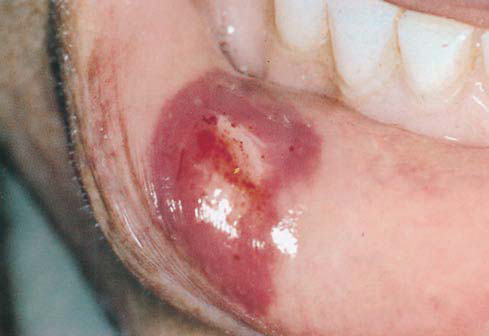Hematoma is the effusion of the blood into the extravascular spaces, resulting from the nicking of a blood vessel, either an artery or vein, during the injection of a local anesthetic in the oral cavity. A hematoma developing subsequent to the nicking of an artery usually increases rapidly in size until treatment is done to it, because of the significantly greater blood pressure within the artery. Nicking a vein may or may not result in the formation of a hematoma. Tissue density surrounding the injured vessel is a determining factor for the Hematoma formation and its size.
a) Cause of Hematoma – How it is formed
b) Problems Due to Hematoma
c) Prevention of Hematoma
d) Management of Hematoma
Discussed below are the cause, problem, prevention and the management techniques of Hematoma that is caused due to improper LA technique. Hematoma can occur anywhere in the body, wherever the injection is given and it ruptures the wall of the blood vessel in such a way that the repair of it does not happen quickly, and the blood is lost continuously into the tissues where it actually does not belong.
Cause of Hematoma
Hematoma is caused due to the increased pressure of the blood vessels, especially the maxillary and mandibular posterior arteries, where the puncture after the posterior superior alveolar nerve block, or the inferior alveolar nerve block leads to the formation, and comparably the areas of hard palate where the density of the tissue is much higher, the hematoma rarely develops in those areas. The tissues surrounding these vessels more readily take significant volumes of blood and enlarge in size. The blood effuses from vessels until extravascular exceeds intravascular pressure or clotting occurs. The Hematomas that are formed after the inferior alveolar nerve block are usually only visible intraorally, whereas the hematomas after the Posterior Superior Alveolar Nerve block are visible extraorally.
Problems due to Hematoma
Hematoma rarely causes any significant problems, but there is a “bruise” resulted intraorally and nothing is usually visible extraorally. Possible complications of hematoma include Trismus and pain. The swelling and discoloration of the region usually subside within 7 to 14 days. A hematoma causes an inconvenience to the patient and an embarrassment to the person administering the drug.
Prevention of Hematoma
Hematoma does not always happen, but at the same time it is not a condition that can be prevented always. Still, there are a few precautions and ways using which one can try to prevent the Hematomas from being formed after the nerve block administration:
- Having the proper knowledge of the normal anatomy involved in the proposed injection site is very important. Certain techniques have a greater risk of visible hematoma. The PSA nerve block is the most common, followed by the Inferior Alveolar Nerve Block and the mental/incisive nerve blocks too are the other common injection techniques after which the Hematoma is seen.
- If at all the patient’s anatomy is a bit different, you need to modify the injection technique. For example, the depth of penetration for a Posterior Superior Alveolar nerve block may be decreased in a patient with smaller facial characteristics.
- Use a short needle for the PSA nerve block to decrease the risk of hematoma.
- Minimize the number of needle penetrations into tissue, as this damages the walls of the blood vessels more. Try to give a single injection with a proper insertion, rather than multiple trials.
- Never use a needle as a probe in tissues.
Management of Hematoma
Check the page Hematoma Management to see how one can manage the Hematoma formed due to LA administration.

hello..sir
can you tell please….
i give infraorbital block..and swelling occur immediately although aspiration was negative…what can be etiology….can i prevent this